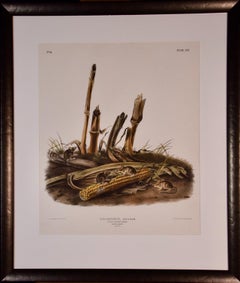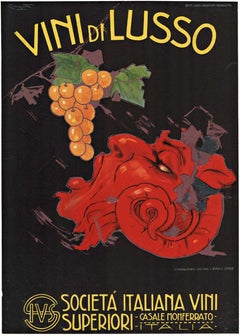John James Audubon Figurative Prints
American, French, 1785-1851
John James Audubon (April 26, 1785, Les Cayes, Saint-Domingue (later Haiti) – January 27, 1851 (aged 65) Manhattan, New York, U.S.), born Jean-Jacques Audubon, was an American ornithologist, naturalist, and painter. He was notable for his expansive studies to document all types of American birds and for his detailed illustrations that depicted the birds in their natural habitats. His major work, a color-plate book entitled The Birds of America (1827–1839), is considered one of the finest ornithological works ever completed. Audubon identified 25 new species.to
1
Overall Width
to
Overall Height
to
123
859
382
378
308
1
1
1
1
1
1
Artist: John James Audubon
"Little Harvest Mouse": A Framed Original Audubon Hand-colored Folio Lithograph
By John James Audubon
Located in Alamo, CA
This rare original first edition Audubon hand-colored imperial folio-sized lithograph entitled "Mud Minimus Aud and Bach, Little Harvest Mouse, Males and Females, Natural Size" was e...
Category
Mid-19th Century Naturalistic John James Audubon Figurative Prints
Materials
Lithograph
Related Items
Meditation and Minou
By Will Barnet
Located in Buffalo, NY
Artist: Will Barnet, American (1911 - 2012)
Title: Meditation and Minou
Year: 1980
Medium: Lithograph and Serigraph on BFK Rives, signed and numbered in pencil
Edition: 40/150
Category
1970s American Realist John James Audubon Figurative Prints
Materials
Archival Paper, Lithograph
Original Vini di Lusso Italian wine vintage poster 1922
By Plinio Codognato 1
Located in Spokane, WA
Original, Italian, Vini di Lusso lithograph vintage poster for fine wines. The Italian Society for Superior Wine. The image of a satyr (or Bacchus) getting ready to eat a group ...
Category
1920s Art Deco John James Audubon Figurative Prints
Materials
Lithograph
$1,299
H 19 in W 13.25 in D 0.05 in
Lithograph Titled: Two Hares in the Moonlight. New York Graphic Society, 1976.
Located in Chesterfield, MI
Lithograph By Cho Tai Eok
Published by New York Graphic Society, 1976.
Measures 39 x 15.5 in.
In Good Condition
Category
20th Century John James Audubon Figurative Prints
Materials
Lithograph
$120 Sale Price
20% Off
H 39 in W 15.5 in
Roy De Forest, Dog lithograph, signed/n by world renowned California pet painter
By Roy De Forest
Located in New York, NY
Roy De Forest
Untitled (Dog), 1981
Color lithograph with deckled edges. Floated and framed.
Pencil signed and numbered from the edition of 125
Frame Included: held in original vintage white frame
Wonderful whimsical rare 1981 lithograph by the incredibly popular and beloved Roy de Forest, famous for his paintings and prints of dogs...
Category
1980s Surrealist John James Audubon Figurative Prints
Materials
Lithograph
$1,700
H 35.25 in W 26.75 in D 1 in
Warner Brothers Orchestra Bugs Bunny Daffy Duck Porky Pig Cartoon Movie Legends
By Albert Al Hirschfeld
Located in New York, NY
Warner Brothers Orchestra Bugs Bunny Daffy Duck Porky Pig Cartoon Movie Legends
Al Hirschfeld (1903-2003)
Warner Brothers Orchestra
Etching and Aquatint
Sight 15 1/4 x 23 1/2 inches...
Category
1990s Performance John James Audubon Figurative Prints
Materials
Paper, Lithograph
“Europa and the Bull”
By Alvar Sunol Munoz-Ramos
Located in San Francisco, CA
You have to hand it to the bull. Not just taking Europa with his unassailable power (he is Zeus in disguise, after all) he brings along a retinue for his seduction of the beautiful P...
Category
1980s Modern John James Audubon Figurative Prints
Materials
Paper, Lithograph
Original "Wonderful Copenhagen" vintage travel poster
Located in Spokane, WA
Original vintage poster: WONDERFUL COPENHAGEN created by the artist Viggo Vagnby. This antique poster is archival linen-backed, in excellent condition, and ready to frame. No da...
Category
1950s American Modern John James Audubon Figurative Prints
Materials
Lithograph
$1,375
H 39 in W 24.5 in D 0.05 in
The Old Horse - Etching by Giovanni Fattori - 1900-1908 ca.
By Giovanni Fattori
Located in Roma, IT
Image dimensions: 20.2 x 15.3 cm.
The Old Horse is a superb original etching (on copper matrix) on paper, signed on plate by the Italian Macchiaioli master...
Category
Early 1900s Naturalistic John James Audubon Figurative Prints
Materials
Etching
$4,631
H 15.83 in W 11.3 in D 0.08 in
In Praise of Prairie Dogs (19-325), 11 Color lithograph, Signed/N Judy Chicago
By Judy Chicago
Located in New York, NY
Judy Chicago
In Praise of Prairie Dogs (19-325), 2019
11 Color Lithograph on light blue Pescia paper
Hand signed, dated and numbered from the limited edition of 95 on the front
22 × ...
Category
2010s Feminist John James Audubon Figurative Prints
Materials
Lithograph
Lait pur de la Vingeanne (Pure Milk from Vingeanne), Lithographic poster.
By Théophile Alexandre Steinlen
Located in La Canada Flintridge, CA
It is framed with black moulding all around.
Era: Late 19th to early 20th century, often categorized under the Art Nouveau movement. The poster litho size is 36"x24", print informat...
Category
Early 1900s Art Nouveau John James Audubon Figurative Prints
Materials
Lithograph
$950
H 37 in W 25 in D 0.75 in
Horse Team - Etching by F. Jacque - Late 19th Century
By Frédéric Jacque
Located in Roma, IT
Horse Team is a black and white etching realized by Frederic Jacque in the late 19th Century.
The artwork represents a farmer and horses struggling with rural jobs
Good condition e...
Category
Late 19th Century Naturalistic John James Audubon Figurative Prints
Materials
Etching
$237 Sale Price
20% Off
H 15.75 in W 21.26 in D 0.08 in
Nixon + Spiro - Zero, Extremely rare 1968 political poster offset lithograph
Located in New York, NY
Unknown Artist
Nixon + Spiro - Zero, 1968
Extremely rare vintage 1960s Offset lithograph poster
28 × 22 inches
Publisher
Published by Joe A. Kennedy; printed by Provo Press
Unframed,...
Category
1960s Modern John James Audubon Figurative Prints
Materials
Lithograph, Offset
$2,000
H 28 in W 22 in
John James Audubon figurative prints for sale on 1stDibs.
Find a wide variety of authentic John James Audubon figurative prints available for sale on 1stDibs. You can also browse by medium to find art by John James Audubon in lithograph and more. Not every interior allows for large John James Audubon figurative prints, so small editions measuring 30 inches across are available. John James Audubon figurative prints prices can differ depending upon medium, time period and other attributes. On 1stDibs, the price for these items starts at $3,975 and tops out at $3,975, while the average work can sell for $3,975.
Questions About John James Audubon Figurative Prints
- 1stDibs ExpertApril 5, 2022John James Audubon is famous for studying and drawing birds. His goal was to document every type of American bird and is known for his detailed illustrations of birds in their natural habitats. Browse a variety of Audubon drawings and art on 1stDibs.
- 1stDibs ExpertMarch 22, 2022John James Audubon's style was realistic, as the primary goal of his work was to capture characteristics of the anatomies and habitats of various bird species. He often used watercolors to produce his paintings. You'll find a selection of John James Audubon art on 1stDibs.


